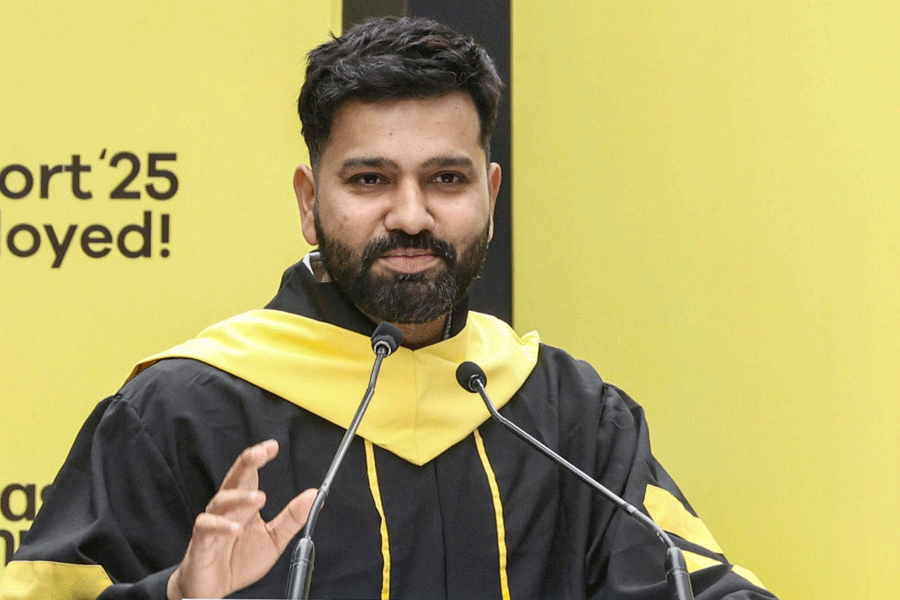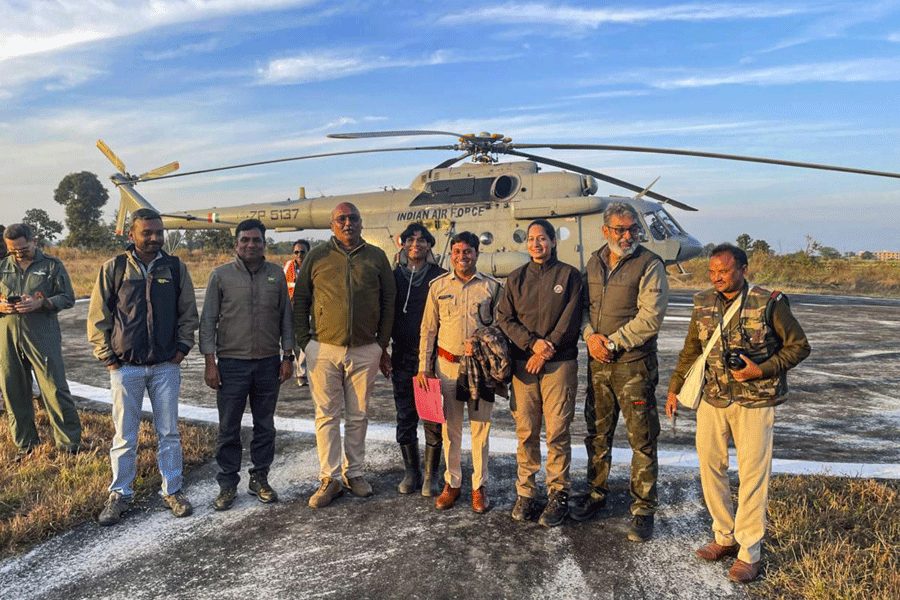A hundred years from today,
Who are you sitting reading a poem of mine,
Under curiosity’s sway,
A hundred years from today…,
(Chitra, 1896)
Rabindranath Tagore had directed these lines in Bengali to an imagined figure from the future reading his poem 100 years on. One wonders if he had imagined such readers could be in China where he had voyaged exactly 100 years ago.
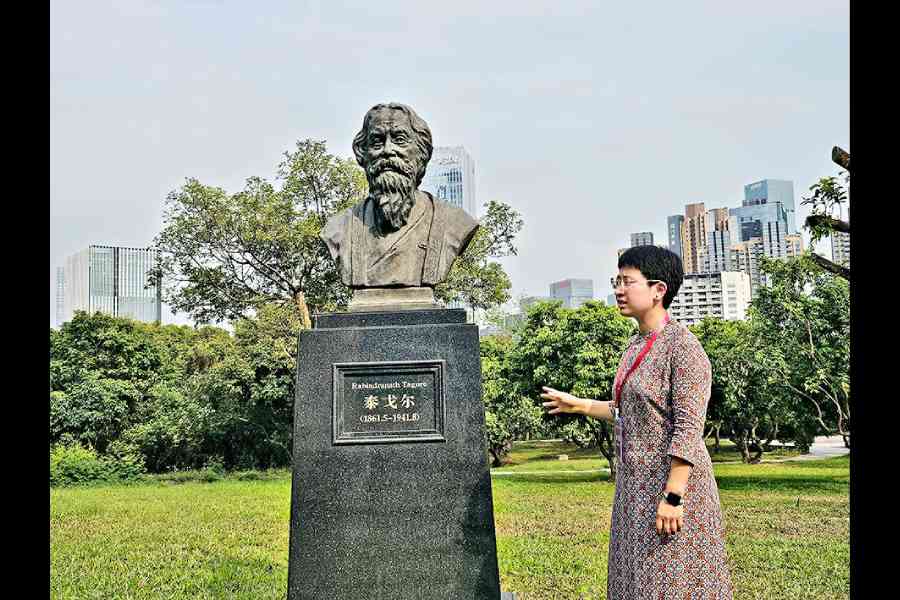
A statue of Tagore in the garden of Shenzhen University
Several universities in China marked the centenary of Tagore’s visit this April, and the consulate general of China flew a delegation of artistes and academics over from Calcutta to attend the programmes.
“The centre of China’s life is in Beijing; the work of the Indian delegation should start from Beijing,” Sun Yat-sen, the Republic of China’s first provisional president, had written to Tagore, when he embarked on the 49-day trip accompanied by Kshitimohan Sen, Nandalal Bose, Leonard Elmhirst, Kalidas Nag, Gretchen Green and Prince Ghanshyam Singh of Limbdi, Gujarat, on an invitation from the Lecture Association of Beijing.
Though Tagore had landed at the Shanghai dock, it is in Beijing where the week-long engagement started for the team from Calcutta that was referred to officially as the “Following Tagore Footstep” delegation in a tweet put out by the Chinese embassy in India on its X account. The delegation comprised former vice-chancellor Sabyasachi Basu Ray Chaudhuri of Rabindra Bharati University (RBU); Avijit Banerjee, head of Cheena Bhavana, Visva-Bharati; Baisakhi Mitra, head of the department of museology and Rabindra Bharati Museum, RBU; Manoj Murali Nair, singer, and Souraja Tagore, dancer and a member of the Pathuriaghata wing of the Tagore family who teaches English at The Bhawanipur Education Society College; other than consul Zhang Zhizhong of the consulate general of China in Calcutta and t2.
Passage through Peking
The first programme of the tour, hosted by the cross-disciplinary thinktank Chinese Academy of Social Sciences (CASS), took place in century-old premises lit up by blooming lilacs which stood sentry to two-storied serene structures of exposed brickwork with brick-red railings.
“Tagore’s visit is significant in the history of the cultural exchange between India and China. Just as Huen Tsang had visited India about 1,300 years ago to imbibe the teachings of Buddhism, Tagore came 100 years ago with a strong sense of the commonality of the two civilisations and shared values. We want to bypass differences and build common ground. This seminar is aimed to build bridges between the two countries. We want more people-to-people exchanges,” said Li Xiangyang, the director-general of the National Institute of International Strategy of CASS.
CASS secretary general Zhao Zhimin also stressed on collaborations with academics from India. “Some scholars have pointed out that India’s view of China is guided by narratives written by the West. Our contacts are more with the West rather than with each other, leading to a bias.”

A cultural festival at Shenzhen University commemorated Tagore’s visit to China
His view was endorsed by Prof. Basu Ray Chaudhuri. “Our territories may have been decolonised but in order to have a harmonious relationship, we need to decolonise our minds and have direct conversations,” he said.
CASS vice-president Jiang Jingkui said that modern Chinese studies started with translations of Tagore, pointing out that the first translator of Tagore was Chen Duxiu, the first general secretary of the Chinese Communist Party.
Though many Chinese intellectuals and youths, especially those sympathetic to left-wing politics, had criticised Tagore’s ‘spiritualism’ and ‘Orientalism’, which they interpreted as opposition to science and modernity, and protest leaflets were distributed during several of his lectures on the tour, it was a Communist leader who had translated four poems of Gitanjali from English into Chinese in 1915, six years before the party was founded in 1921.
“While traditional Indian studies in China are focused on Buddhism, there is a big market now on modern South Asian studies. Half of that is on Tagore,” said Jingkui, who teaches at the department of foreign language and literature at Tsinghua University, which was one of the two universities Tagore had visited in Beijing. “We are marking the centenary by holding an international conference and an exhibition on Tagore’s visit as well as dedicating a bookshelf in our library to Tagore’s works,” he added.
Tagore’s presence in Chinese academia is not restricted to universities. In attendance were two Class X students from the Tagore class of Beijing 101 Middle School. Speaking to t2 on the sidelines of the meet, Sireng Meng and Jingyuan Zong said that their classes were named after international figures, some of the others being anthropologist Jane Goodall, founder of Boy Scouts of America, William D. Boyce and curiously, George Orwell, author of the anti-totalitarian Animal Farm and Nineteen Eighty-Four. “We share quotes and trivia about the icon our class is named after in our respective class social media groups,” said Sireng, who calls herself Isabel.
It is common in China for young people to take a Western nickname. Jingyuan introduced himself as Andy.
The next day, we reached Peking University well before the seminar and were received at the Foreign Language building. In the foyer, there was a bust of Tagore, gifted by President K.R. Narayanan. The statue would find mention in the opening remarks of Prof Ming Chen, head of the department of South Asian Studies, at the seminar as well.
The campus is in the lap of an imperial garden dating back to the Qing Dynasty. It was in full bloom with lilacs and peach blossoms — just as it must have been when Tagore had visited. Black swans and ducks waddled on the bank as we walked towards the most famous landmark on campus, Weiming hu, which translates to “a lake without a name”. “In winter, the lake freezes over and the ice is thick enough to skate on,” said a student accompanying us as pictures were taken by the lake with the Boya Pagoda as backdrop.
Souraja gave a short and lucid talk on Rabindranritya, which she demonstrated with Nair singing Aji dakhin duwar khola and Akash bhora surja tara in his mellifluous voice.
The commemoration harked back to May 8, 1924 in the same city when young Chinese actors of the Crescent Moon Society had performed Tagore’s play Chitra in English in his presence to celebrate his 63rd birthday. Many of Tagore’s works such as The Crescent Moon and Chitra were available in Chinese by then. The works had inspired poet Xu Zhimo and his friends to organise the Crescent Moon Society in Peking (Beijing).
On the day, Tagore had received the gift of a name, Chu Chen-dan (meaning India China), from Indologist Liang Qichao at a public reception, an act which Qichao hoped would revive the “old love between the Indians and the Chinese”. Tagore would recall the celebration years later, ahead of his 80th birthday, in a poem:
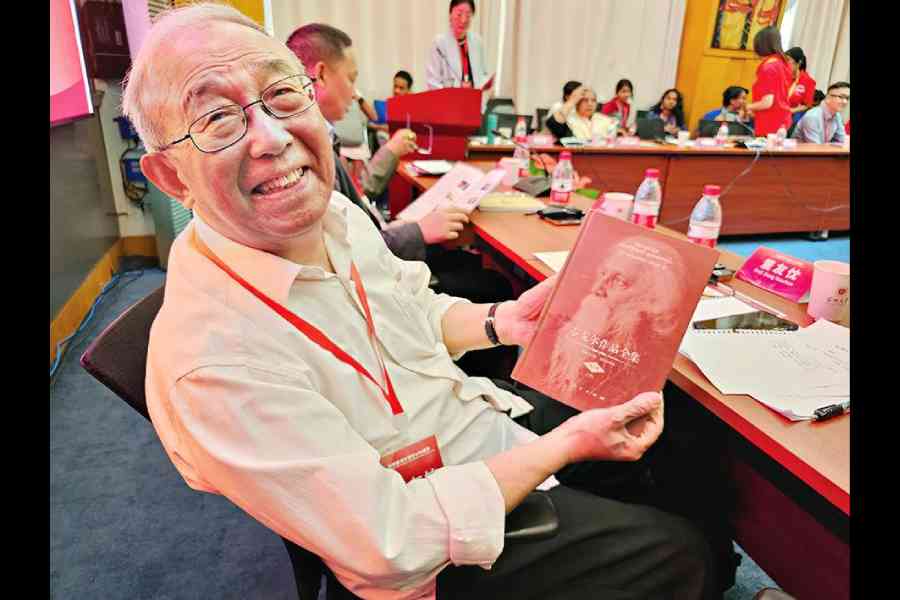
Prof Don Youchen, the editor-in-chief of the Chinese translation of The Complete Works of Tagore
“…Once I went to the land of China,
Those whom I had not met
Put the mark of friendship on my forehead…
A Chinese name I took, dressed in Chinese clothes…”
Shanghai saga
A park opposite the Shanghai International Shipping Service Centre on the bank of the Huang Pu river has a plaque describing the spot as the Huishan Wharf. It bears a logo — an outline of a door with the hammer and sickle atop. An inscription in Chinese, put up by the history research office of the Shanghai Municipal Committee of the Communist Party of China, Shanghai Municipal Cultural Relics Bureau, says this is the spot from where young students boarded the ship to work and study in the West. Many of them accepted Marxism while studying abroad. It is presumed that this is where Chinese intellectuals had gathered to receive Tagore when his ship had docked on April 12, 1924.
Even today, it is a busy waterway with boats of various shapes and sizes sailing by.
Equally busy is the crossing of Maoming Road and Nanchang Road, which was our next stop. A bust of Tagore stands here. Huang Yangbing, an official from the Shanghai People’s Association for Friendship with Foreign Countries (SPAFFC) who took us, had thoughtfully arranged for a bouquet with flowers mentioned in Tagore’s works for the delegation to offer at the spot. The statue, she mentioned, had been installed as part of Tagore’s 150th birth anniversary celebrations. A large number of local Indians and Chinese as well as visiting students and teachers from Tagore International School (TIS), Delhi, had attended the occasion. The Indian students were visiting Shanghai for a joint cultural performance with students of Jinyuan Senior High School.
The school was also on our itinerary for the day. “In August 2007, 16 Indian teachers and students had visited us for the first time, facilitated by SPAFFC, and we had signed an MoU for friendly exchanges. Since then, there have been 10 reciprocal visits involving a total of 126 teachers and students. Our President Xi’s wife had visited the school in Delhi and seen Tai Chi and yoga classes. We are committed to joint exploration of each other’s traditional culture and broaden the horizons of friendship,” said Lu Ming, the English-speaking vice-principal of Jinyuan Senior High School.
Speaking on behalf of the delegation in fluent Chinese, Banerjee, the Cheena-Bhavana director, said: “Exchange between younger generations is the need of the hour. When students visit each other they help remove misconceptions about their countries. Tagore’s aim too was to forge cultural and educational ties. His influence is perceived on Chinese writers of the time, like the female poet Bin Xin who also translated Tagore. Xu Zhimo spent seven years at our university. Tagore started a tea circle in his name. He remains relevant in Indo-China relations.”
The delegation witnessed an online class in which students seated in Delhi were watching and learning from art teacher Jiang Hao, with a camera focused on his deft brushstrokes.
At the Indian dance speciality class, Souraja taught Grade XI students the steps of Phule phule dhole dhole with an interpreter helping her explain the lyrics to them. Nair sang the song and later played it on the piano. “We recorded the tune. We might include the dance at a school programme,” the vice-principal said, while taking the delegation on a school tour.
Curiosity made t2 pause on spotting square markers with an inner binary matrix in the school courtyard. “Those are Aruco markers, used for training students to operate drone cameras,” the vice-principal said. A brush with cutting- edge technology for school students!
We headed for Tongji University in the afternoon. The International School had put up an exhibition showcasing earlier seminars and the seminal work by dean of the International School Sun Yixue, who has written five books on Tagore and edited a collection of essays. “Every educated Chinese knows Tagore. We remember him not just because of his poems but also his ideas,” he told t2.
The Tagore trail in Shanghai ended with a visit to Simingcun — an unremarkable block of 19th century ‘shikumen’ houses, a type of tenement unique to Shanghai with a stone gate at the entrance. It is here that Tagore had put up during two of his three visits to China — at the home of Xu Zhimo and his wife Lu Xiaoman. The young poet, Tagore’s interpreter on the trip, called Tagore his “Rubidadda” while Tagore had named him “Susima”.
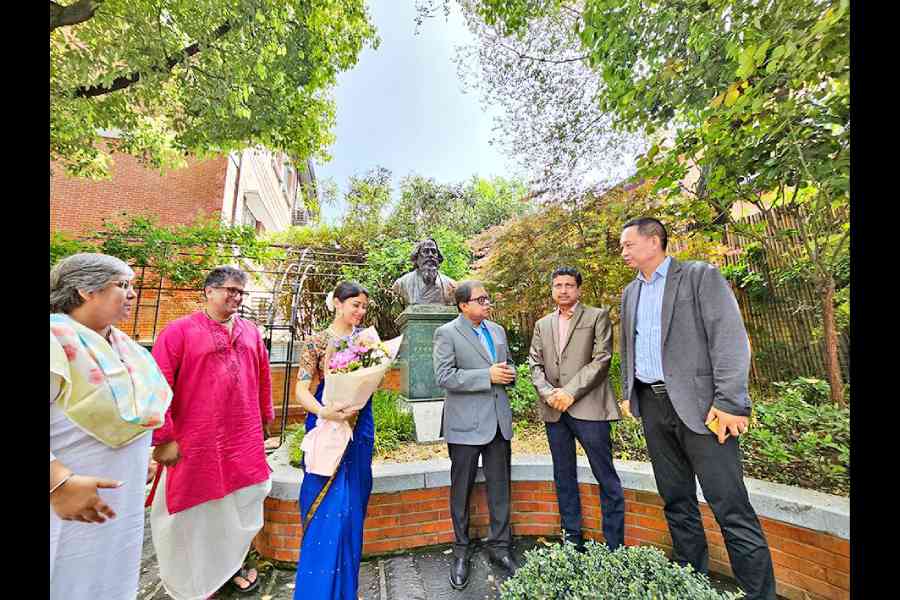
“Following Tagore Footstep" delegation comprised (L-R) Baisakhi Mitra, head of the department of museology and Rabindra Bharati Museum, RBU; Manoj Murali Nair, singer; Souraja Tagore, dancer and a member of the Pathuriaghata wing of the Tagore family who teaches English at The Bhawanipur Education Society College; Sabyasachi Basu Ray Chaudhuri, former vice-chancellor of Rabindra Bharati University; Avijit Banerjee, head of Cheena Bhavana, Visva-Bharati; and consul Zhang Zhizhong of the consulate general of China in Calcutta
No. 923 shikumen has been razed to make way for Yan’an Elevated Road that connects the west and east of Shanghai. We walked by houses that survived the bulldozer, typified by their red-brick outer walls. A plaque near the entrance lists, in both English and Chinese, the literary and historical figures who once lived in this now-decrepit colony. Among them is Tagore’s name.
Fast forward Shenzhen
Tagore did not visit Shenzhen, the third city on the Tagore Footsteps tour. Other than being the last stop on the Chinese side on the Kowloon-Canton Railway that was opened to the public in 1911, the town had little to commend itself. Its spectacular rise to being the third most populous city of China was triggered by its designation as the first Special Economic Zone of China in 1980. Today, what was a fishing village 44 years ago rivals Chicago in its number of skyscrapers.
Shenzhen University was hosting a two-day commemoration of Tagore’s visit. The first evening featured artistes from both countries in a China-India Classical Music Concert. Sarod, harmonium and tabla recitals alternated with performances with guqin, a Chinese string instrument.
The next day, a symposium featured Prof Don Youchen, the editor-in-chief of the complete works of Tagore, among other noted academics. The venerable octogenarian spoke passionately about Tagore’s humanitarian world-view, high morals and sense of justice, which led him to support China in the face of Japanese aggression and renounce knighthood after the Jalianwala Bagh firing.
The audience was enthused to witness Baisakhi Mitra’s audio-visual presentation on the Tagore Museum at Jorasanko, focused on its China gallery. Many clicked pictures of the screen as she took viewers on a tour of the living quarters of the Bard and his personal effects.
Afterwards, the delegation was taken to the Tan Yun-Shan Sino-Indian Friendship Museum, named after the founder of Cheena Bhavana, and then to a statue of Tagore in the university garden. “It was gifted to us by the Indian Council of Cultural Relations, which had also sent the statues you saw in Beijing and Shanghai. While the President of India had inaugurated those, we are still awaiting an Indian dignitary to do the honours here. Twice the Indian ambassador was scheduled to come but his flight could not land due to bad weather,” lamented Prof Yu Longyu, the 78-year-old director of the Centre for Indian Studies at Shenzhen University. “Perhaps Tagore wants the President or the Prime Minister of India to visit us,” he added with a twinkle in his eyes.


